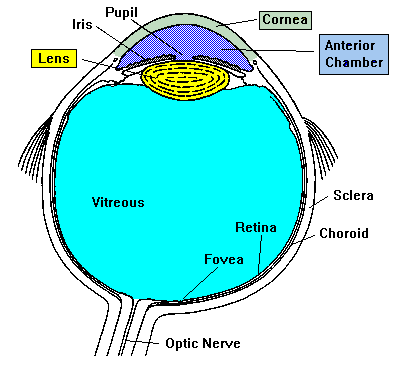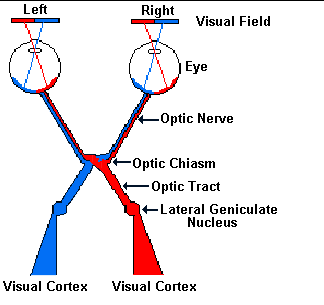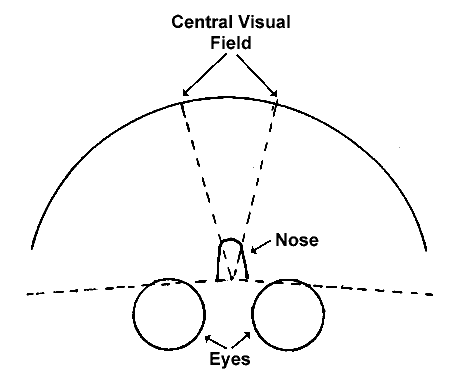Our Sense of Sight: Eye Anatomy and Function

|
Our Sense of Sight:Eye Anatomy and Function Developed by Marjorie A. Murray, Ph.D.; Neuroscience for Kids Staff Writer |

|
|
||||||||||||||||||||||||||||||||||||
| Our visual systems perform all kinds of amazing jobs, from finding constellations in the night sky, to picking out just the right strawberry in the supermarket, to tracking a fly ball into a waiting glove. How do our eyes and brains recognize shape, movement, depth, and color? How do we so easily pick a friend's face out of a crowd, yet get fooled by optical illusions? In this first of three units on the Sense of Sight, we consider the anatomy and physiology of the eye, especially the retina, and the initial pathways visual information takes to the brain. Part 2 discusses how various aspects of a visual scene are processed at higher levels, and Part 3 delves into color vision. 1. Our eyes allow us to perceive electromagnetic radiation reflected from objects Most animals and many plants are photosensitive; that is, they can detect different light intensities. Some organisms accomplish this with single cells or with simple eyes that do not form images but do allow the organism to react to light by moving toward or away from it. In order for an eye to transmit more information about the world, however, it must have a way of forming an image, a representation of the scene being viewed. Higher invertebrates and virtually all vertebrates have complex, image-forming eyes, and we will "focus" on the refracting eye found in the octopus and in all vertebrates. Arthropods have compound eyes, which have greater depth of focus than refracting eyes, but which sacrifice resolving power or acuity. Our eyes, like those of many animals, detect a just narrow range of all the wavelengths of electromagnetic radiation, that between 380 and 760 nanometers. This range of light is called the visible spectrum. Figure 1 shows how the visible spectrum fits into the entire electromagnetic spectrum.  Figure 1. The electromagnetic spectrum and the visible spectrum. 2. The eyeball is an optical device for focusing light The mammalian eyeball (Figure 2) is an organ that focuses a visual scene onto a sheet of specialized neural tissue, the retina, which lines the back of the eye. Light from a scene passes through the cornea, pupil, and lens on its way to the retina. The cornea and lens focus light from objects onto photoreceptors, which absorb and then convert it into electrical signals that carry information to the brain. Two pockets of transparent fluid nourish eye tissues and maintain constant eye shape: these are the aqueous and vitreous humors, through which the light also passes. The lens projects an inverted image onto the retina in the same way a camera lens projects an inverted image onto film; the brain adjusts this inversion so we see the world in its correct orientation. To control the images that fall upon our retinas, we can either turn our heads or turn our eyes independently of our heads by contracting the extraocular muscles, six bands of muscles that attach to the tough outside covering, or sclera, of the eyeball and are innervated by cranial nerves. See Table 1 for a brief list of eyeball components and their functions. The cornea and lens bend or refract light rays as they enter the eye, in order to focus images on the retina. The eye can change the extent to which rays are bent and thus can focus images of objects that are various distances from the observer, by varying the curvature of the lens. The ciliary muscle accomplishes this by contracting to lessen tension on the lens and allowing it to round up so it can bend light rays more, or relaxing for the opposite effect. This ciliary muscle is smooth or non-voluntary muscle-you cannot "decide" to contract or relax it as you do the skeletal muscle in a finger or facial muscle.  Figure 2. The mammalian eyeball. 3. Refractive errors in the eye cause focusing problems Refractive errors occur when the bending of light rays by the cornea and lens does not focus the image correctly onto the retina. An eyeball that is too long or too short for the optics of the cornea and lens or an irregularly shaped cornea can cause refractive errors, which include myopia (near-sightedness), hyperopia (far-sightedness), and astigmatism. Myopia results either when the eyeball is too short or when the cornea is curved too much, and the focused image falls in front of the retina. Hyperopia is the opposite, with the image falling behind the retina. Astigmatism results from a cornea that is not spherical. Fortunately, most refractive errors can be corrected with prescription lenses.
4. The retina originates from the brain and contains photoreceptors for detecting light The eye is formed during embryonic development by a combination of head ectoderm and neural tube tissue, the latter forming the retina. Thus, the retina is not a peripheral sensory organ like skin touch receptors or taste buds on the tongue, but rather it is an outgrowth of central nervous tisse. Because of this origin, the retina has layers of neurons, internal circuits, and transmitters characteristic of the brain: it is a bit of the brain that has journeyed out, literally, to have a look at the environment. The photoreceptors in the retina are of two types: rods and cones, so named because of their shapes. These cells are actually specialized neurons that detect light. Embedded in stacks of cell membranes in the distal portions of rods and cones are molecules that absorb certain wavelengths of light. These molecules are called photopigments and are composed of two parts: a large trans-membrane protein, an opsin, and a smaller chromophore, which is a metabolite of Vitamin A called 11-cis-retinal. The chromophore, which is embedded in the opsin, absorbs light; in so doing it undergoes a shape change. This shape change in turn activates the opsin, setting off a cascade of events that leads to a change in the electrical state of a rod or cone cell membrane. This change in the rod or cone cell membrane is then conducted via the rod or cone axon to other neurons in the retina, and from there to the brain. 5. Rods function in dim light In dim light, we use our rods, which cannot work in bright light. Rods outnumber cones (120 million rods and about 6 million cones in each retina) and they amplify a light signal much more than cones. Scientists have demonstrated that absorption of even a single quantum (or photon) of light can trigger a chromophore shape change in one molecule of rhodopsin in a rod, leading to signal transmission. For transmission to occur, this initial tiny event must be amplified: the activated molecule of rhodopsin converts several thousand molecules of the next enzyme in the cascade to the active form, and this amplification continues until the electrical potential of the cell membrane changes and neurotransmitter release is affected. Cones, on the other hand, must each absorb hundreds of photons in order to send signals. Another retinal mechanism that helps us to see in dim light or to see a tiny amount of light in the dark is the convergence of rod cell signals onto other retinal neurons. Many rods (up to 150) synapse onto the same target neurons, where the signals are pooled and reinforce one another, increasing the ability of the brain to detect a small amount of light. (A synapse is a contact between a neuron and another cell where an electrochemical signal [most commonly] is transmitted to the second cell.) This convergence amplifies weak signals, but spatial resolution is lost because rod responses are averaged. That is, we cannot see fine detail using rods. In order for our eyes to make the transition to dim light, rods must adapt after being saturated with light in brighter conditions. Dark adaptation of rods takes seven to ten minutes: during this time rhodopsin molecules, in which the chromophore components have changed to the activated state, return to the non-activated state so that they are able once again to register changes in illumination. Other changes also occur in adaptation to dark or dim conditions, including enlarging or dilating of the pupil, which is controlled by the autonomic nervous system. 6. Cones mediate day vision Our vision in bright or moderate light is completely mediated by cones, which provide color vision, black and white vision, and high acuity, the ability to discern fine detail. Like rods, cones contain an opsin and the chromophore 11-cis-retinal, but the opsins differ from rhodopsin so that each cone is responsive to one of three colors: red, green or blue. Cones are spread throughout the retina but are especially concentrated in a central area called the macula. At the center of the macula is the fovea, where only cones (no rods) are found, and these are densely packed. When we want to read or inspect fine detail, we move our heads and eyes until the image of interest falls onto the fovea. Because the fovea lacks rods, it is easier to see in dim light by looking to the side of an object instead of directly at it. You can test this by looking to the side of a faint star so that its image falls on rods, rather than on the fovea where it probably will not register. When you look directly at the faint star, it disappears. In contrast to the wiring of rods, only a few cones converge onto other retinal neurons to average their signals, so cones provide better spatial resolution. In fact, each cone in the fovea synapses onto only one neuron in the next relay in the retina. This gives this area the ability to transmit fine detail, such as we use in reading. Thus, cones mediate day vision and rods take over in dim light and at night. Both rods and cones can operate at the same time under some conditions: in dim or dark conditions, rods are most sensitive, but cones respond to stimuli that are sufficiently bright. This is why we can see the colors of neon lights on dark nights. 7. Visual information travels from retinal ganglion cells to the brain After converting light into electrical signals in their cell membranes, rods and cones transmit this information to other neurons in internal circuits in the retina for processing. From these cells, messages go to the final retinal station, the ganglion cells, whose axons exit the eyeball at the optic disc and form the optic nerve, which contains about one million axons. Because all the nerve fibers converge at the optic disc, no rods or cones are in this area and it forms a "blind spot" on the retina. Within the optic nerve, a defined group of axons from each eye crosses over to join the opposite optic nerve at the optic chiasma (see Figure 3), so each side of the brain receives visual information from both eyes. After the chiasma, retinal axons go to one of three areas: two of these are in the midbrain and one is in the thalamus. The information going to the midbrain does not reach conscious levels but rather produces pupillary reflexes (which are controlled by the autonomic nervous system) and eye movements. In the thalamus, ganglion cell axons transmit signals to neurons in the lateral geniculate nucleus (LGN) where information is processed and then carried by LGN axons to the primary visual cortex in the occipital lobe of the cerebrum. These cortical cells then send messages to other "higher" cortical areas. Figure 3 shows the anatomy of this system (the midbrain areas are not shown here).  Figure 3. The visual pathway 8. We have an area of central or focused vision and an area of peripheral vision within our fields of vision The visual field is defined as the view seen by the two eyes while looking straight ahead (Figure 4). Without moving eyes or head, a person can see details (well enough to read) within a limited angle drawn from a point between the eyes on the forehead and two experimentally determined points to the left and right in front of the viewer, at proper focal distance. In addition to this area of clear or central vision, we can see objects and movements to the sides of our heads, although as the distance around to the sides increases, it becomes more difficult to identify objects. The area of central vision includes objects whose images fall onto the central area of the retina, the macula, and especially the fovea (defined above). Cones in all other areas of the retina are in the periphery, and while they convey visual information, they do not provide the resolving power of the densely packed fovea.  Figure 4. Complete visual field and central visual field, looking down onto the head. The complete visual field is the entire area in front of the eyes from the end of one lateral dashed line to the other (including the central visual field). In addition to speaking of a central and a peripheral field of vision, we can divide these fields by a vertical line down the middle into right and left visual fields. Because of the way ganglion cell axons cross at the optic chiasma, information from the entire right visual field (to the right of a vertical line) goes to the left LGN, and from the left LGN, all axons go to the left occipital cortex (Figure 3). Similarly, all left visual field information goes to the right occipital cortex. Remember that although each visual cortex receives information only from the opposite visual field, this information is collected by defined parts of both eyes. 9. Projections from the retina to the brain generate retinotopic maps As in the touch sensory system (and to some extent, other sensory systems), visual information is mapped in an orderly fashion onto neurons in the LGN of the thalamus. Further, this topographic mapping continues when LGN neurons carry signals to the visual cortex. As in the touch system, the mapping of the visual field is not isometric; that is, not every area of the visual field is represented in proportion to its size. Rather, the density of sensory neurons in a given area of the retina determines how many central neurons are devoted to that retinal area, as in the touch system where fingertips and lips have a much larger representation in the parietal cortex than do trunk and arms. In the LGN and primary visual cortex, about half of the neurons receive input from the fovea (the eye's "fingertips") and area just around it, where cones are densely packed and visual acuity is highest. 10. Defined groups of neurons in the primary visual cortex process different aspects of visual information Several attributes of visual information go to the primary visual cortex: motion, form or shape, and color. These aspects of the visual scene travel to different modules or groups of cortical cells (some are given names such as "columns" or "blobs.") In order for us to perceive and interpret these kinds of visual information, other brain areas beyond the primary visual cortex must process the signals and put the visual scene back together. 11. Problems in different parts of the visual system can cause blindness People who lose cone vision are legally blind, whereas loss of only rod function results in night blindness. Legal blindness is defined as 20/200 vision or worse; that is, a person is considered legally blind if he or she must be 20 feet away to see an object that a person with normal vision can see at 200 feet. Some forms of blindness result from damage to both rods and cones, while others originate with problems in different parts of the visual system. For example, people with damage to particular parts of the cerebral cortex lose specific aspects of vision, such as ability to see parts of the visual field, or to perceive motion, or to recognize faces. |
||||||||||||||||||||||||||||||||||||
Views: 138
Tags:
Welcome to
THE VISUAL TEACHING NETWORK
About
© 2025 Created by Timothy Gangwer.
Powered by
![]()



You need to be a member of THE VISUAL TEACHING NETWORK to add comments!
Join THE VISUAL TEACHING NETWORK